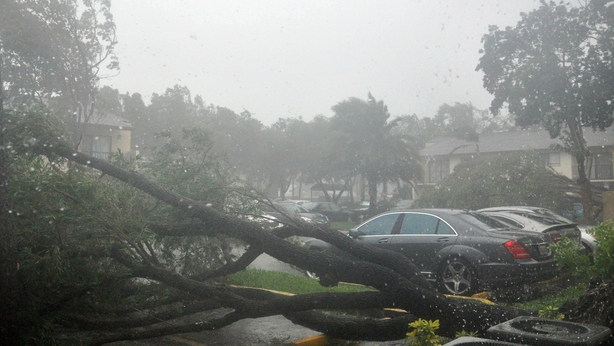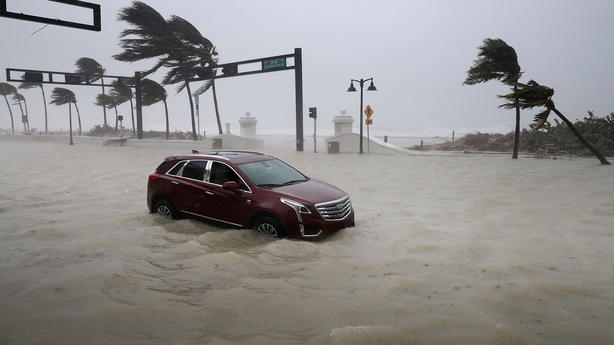Shocked Florida residents are returning to their shattered homes as the weakened Hurricane Irma pushed inland, flooding cities in the northeastern part of the state and leaving millions without power.
Downgraded to a tropical storm early today, Irma had ranked as one of the most powerful Atlantic hurricanes recorded.
It cut power to around 5.8 million homes and businesses and ripped roofs off homes as it hit a wide swath of Florida on Sunday and today and moved into neighbouring states.
Authorities said the storm had killed 39 people in the Caribbean, including ten in Cuba, and one in Florida, a man found dead in a pickup truck that had crashed into a tree in high winds on the Florida Keys over the weekend.
With sustained winds of up to 60 mph (100 kph), Irma had crossed into the state of Georgia and was located about 76km (47 miles) northeast of the Florida state capital Tallahassee, the National Hurricane Center said tonight.
Northeastern Florida cities including Jacksonville suffered flash flooding, with the city's sheriff's office pulling residents from waist-deep water.
"Stay inside. Go up. Not out," Jacksonville's website warned residents. "There is flooding throughout the city and more rain is expected."
Florida's biggest electric company said its outages came to more than 3.6 million by this afternoon.
A total of 4.2 million Florida Power & Light customers have been affected, and full restoration of power could take weeks in many areas due to expected damage to FPL's system, the Next Era Energy Inc unit said.
Much of the state's east and west coasts remained vulnerable to storm surges, when hurricanes push ocean water dangerously over normal levels.

US President Donald Trump vowed a full response to Irma, as well as continued federal support for victims of Hurricane Harvey, which flooded Texas.
"These are storms of catastrophic severity and we are marshalling the full resources of the federal government to help our fellow Americans," Mr Trump said in a ceremony to mark the anniversary of the 9/11 attacks.
"When Americans are in need, Americans pull together and we are one country."
The state's largest city, Miami, was spared the brunt of the storm but still saw heavy flooding.
Utility crews were already on the streets there clearing downed trees and utility lines. All causeways leading to Miami Beach were closed by police.
It has been estimated the storm has caused between $20bn and $40bn in damage to property as it tore through Florida.
Police in Miami-Dade County said they had made 29 arrests for looting and burglary.
In Pictures - Hurricane Irma hits Florida
Damage appeared to be severe in the Florida Keys, where Irma first came ashore as a Category 4 hurricane with sustained winds of up to 215km/h in the early hours of yesterday Monroe County Emergency Director Martin Senterfitt said.
A large military airborne relief operation was being prepared to take help to the chain of islands, which are linked by a dramatic series of bridges and causeways from Key Largo almost 160km southwest to the city of Key West, Mr Senterfitt told a teleconference.
Irma brought gusts of up to 160km/h and torrential rain to areas around Orlando, one of the most popular areas for tourism in Florida because of its cluster of theme parks, the National Weather Service said.
In Daytona Beach, a city on the east coast about 90km northeast of Orlando, city streets were flooded and emergency authorities carried out several water rescues, the Daytona Beach Police Department said on Twitter.
Over the weekend, Irma claimed its first US fatality – a man found dead in a pickup truck that had crashed into a tree in high winds in the town of Marathon, in the Florida Keys, local officials said.

Irma was ranked a Category 5, the rare top end of the scale of hurricane intensity, for days, and carried maximum sustained winds of up to 295km/h when it crashed into the island of Barbuda on Wednesday.
Ahead of Irma's arrival, some 6.5 million people in southern Florida, about a third of the state's population, were ordered to evacuate their homes.
High winds snapped power lines and left about 5.8 million Florida homes and businesses without power, state data showed.
Hurricane Irma downgraded to Category One Storm after battering Florida, leaving a trail of destruction in its path https://t.co/fUzsNUwrRE pic.twitter.com/0qJMcWCuNx
— RTÉ News (@rtenews) September 11, 2017
Many of the evacuation orders extended until at least today due in part to flooding, massive power outages and downed electric lines, leaving residents unable to return to their homes to survey any damage.
TV news video of damage in Naples, a city on the Gulf coast 200km northwest of Miami, showed buildings ripped apart by winds and streets flooded by rain and storm surges.
Irma was forecast to weaken to a tropical storm as it moved near Florida's northwestern coast later today, the National Hurricane Center said.
It would cross the eastern Florida Panhandle and move into southern Georgia later in the day, dumping as much as 41cm of rain, it said.
Five tornados were reported in Florida yesterday, causing damage to several structures but there were no indications of anyone being seriously injured, the National Weather Service said.
Along with hurricane warnings and watches in Florida, the weather service placed tropical storm warnings for large parts of Alabama, Georgia and South Carolina.
The densely populated Miami area was spared the brunt of Irma, although the hurricane's wide reach meant the state's biggest city was still battered.
Miami apartment towers swayed in the high winds, three construction cranes were toppled, and streets flooded between office towers.
The storm and evacuation orders caused major disruption to transportation in the state, which is a major tourist destination and which accounts for about 5% of US gross domestic product.

